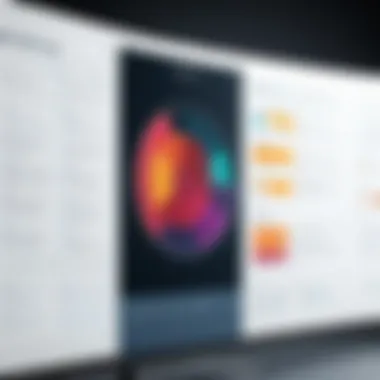Flowchart Applications: A Comprehensive Overview


Intro
Flowcharts serve as a fundamental tool for visualizing processes, ideas, and data. Their applications extend across various industries including finance, education, healthcare, and technology. In today’s complex world, organizations and professionals strive for clarity and efficiency. Flowcharts simplify the intricate webs of information, enabling stakeholders to grasp concepts swiftly. This article will explore the different flowchart applications available, and emphasize their importance, benefits, and future directions in our constantly changing digital environment.
Software Overview and Benefits
Various flowchart software has emerged, each equipped with unique features designed to enhance usability and functionality. For instance, Lucidchart allows users to create flowcharts through an intuitive drag-and-drop interface that encourages collaboration. Similarly, Microsoft Visio is renowned for its rich templates and integration with other Microsoft products, appealing particularly to corporate environments.
The core advantages of these tools include:
- Enhanced Clarity: Visually represent complex processes.
- Improved Communication: Provide a common understanding among stakeholders.
- Increased Efficiency: Streamline workflow enhancements and adjustments.
For businesses looking to address specific needs, these benefits can translate into tangible results such as reduced miscommunication and quicker decision-making.
Pricing and Plans
When considering flowchart applications, pricing structures are crucial. Lucidchart offers tiered subscription plans, including a free version with basic features and higher tiers that unlock more advanced capabilities. The pricing starts around $7.95 per month for individual users, while Microsoft Visio typically begins at $15 per month.
Compared to competitors like SmartDraw, which has a one-time payment option, the subscription bundles from these software platforms may seem costlier in the long term for some users but provide consistent updates and customer support.
Performance and User Experience
In terms of performance, software like Draw.io is noted for its speed and reliability. Users report minimal lag times even when handling large diagrams. The user interface is generally straightforward, making it accessible to individuals at all skill levels.
Feedback from users indicates the importance of a smooth user experience. The majority find the collaboration features of Lucidchart particularly beneficial. This functionality allows multiple users to edit in real-time, fostering teamwork and making the software a preferred choice for many project-driven environments.
Integrations and Compatibility
The effectiveness of a flowchart application is often determined by its ability to integrate with other tools. Lucidchart, for example, seamlessly integrates with platforms like Google Drive, Slack, and Microsoft Teams, ensuring that users can work within their existing frameworks. Such integrations can significantly enhance workflow and accessibility.
Compatibility is also a consideration. Most modern flowchart applications are web-based, allowing use on various operating systems such as Windows, macOS, and Linux. Mobile compatibility is an added advantage for professionals on the move.
Support and Resources
To maximize the benefits of flowchart software, adequate support options and resources are essential. Lucidchart offers customer support via email and live chat, alongside a robust library of tutorials and guides. Users can access webinars that dive deep into advanced features to boost their skills.
Similarly, Microsoft Visio provides comprehensive resources, including official documentation and online help forums. These materials serve to enhance user experience and ensure that individuals can navigate the software effectively.
"Investing in the right flowchart tool not only improves process visualization but also promotes overall operational efficiency."
Prolusion to Flowchart Applications
Flowchart applications play a crucial role in translating complex processes into visual representations. They help in clarifying workflows, outlining steps in a project, and aiding decision-making. In this article, we will explore the impact of flowchart applications across various fields, providing insight into their practical applications.
Defining Flowchart Applications
Flowchart applications are tools designed to create diagrams that outline the sequence of operations or decisions in a process. These diagrams, known as flowcharts, help users visualize relationships among different activities or steps. In an era where efficiency and clarity are paramount, flowchart applications have become essential in numerous sectors including business, education, engineering, and more.
Benefits of Using Flowchart Applications
The primary benefit of flowchart applications is their ability to simplify complex information. This simplification aids users in understanding intricate processes without overwhelming details. Additionally, these applications promote better communication among team members by providing a common visual language. Some key benefits include:
- Clarity: Flowcharts break down processes into digestible parts.
- Collaboration: They facilitate discussions by ensuring everyone is on the same page about the workflow.
- Efficiency: Users can quickly identify bottlenecks and redundant steps, leading to streamlined processes.
Considerations for Choosing Flowchart Applications
When evaluating flowchart applications, several factors ought to be considered. The following elements are critical in determining the right fit for a team or organization:
- User Interface: A clear and intuitive design enhances usability.
- Integration Capabilities: Compatibility with other software tools can streamline processes.
- Customizability: Flexibility in various features allows users to tailor flowcharts to their needs.
- Collaboration Features: Tools that support team collaboration can improve efficiency.


Epilogue
Overall, flowchart applications serve as essential tools for various tasks and industries. They assist in visualizing workflows, enhancing comprehension, and improving productivity. The proper selection of flowchart applications can significantly impact an organization’s ability to convey information clearly, making informed decisions easier. This article continues to delve deeper into the significance of flowchart applications across diverse fields.
The Importance of Flowcharts in Diverse Fields
Flowcharts serve as a vital tool across diverse fields, facilitating the understanding and optimization of complex processes. They simplify the representation of workflows, decision points, and tasks, making them essential not only for clarity but also for efficiency. A well-structured flowchart can eliminate ambiguity, providing a clear visual representation of steps involved in a process. This clarity aids decision-making, enhances communication, and promotes consistency.
In the context of business operations, flowcharts can streamline processes, minimize errors, and improve productivity. They allow teams to visualize workflows, identify bottlenecks, and implement improvements. The visual nature of flowcharts means that they can be easily interpreted by stakeholders across various levels of expertise. This characteristic is advantageous for training new employees and aligning project stakeholders.
Educational Uses of Flowcharts can also not be overlooked. Educators frequently utilize flowcharts to explain complex concepts, organize information, and support critical thinking. These visual aids enhance retention of knowledge and provide students with a method to map out their ideas organically. The utilization of flowcharts in academia has proven instrumental in supporting various learning strategies, especially in subjects that involve problem-solving.
In engineering and technical applications, flowcharts play a crucial role in system design and analysis. Engineers can leverage flowcharts to model control systems, which allow them to visualize system behavior effectively. When documenting engineering processes, flowcharts simplify the communication of technical procedures, making it easier for teams to collaborate on intricate projects.
Flowcharts enhance understanding. They break down complex information into digestible pieces.
As industries continue to evolve, the importance of integrating flowcharts into everyday practices is becoming increasingly clear. Not only do they foster clarity and understanding, but they are also invaluable in identifying opportunities for improvement in various fields. In summary, flowcharts are not merely visual representations; they are instrumental in driving efficiency and effectiveness in diverse fields, benefiting businesses, educational institutions, and engineering disciplines alike.
Key Features of Effective Flowchart Applications
When considering flowchart applications for various tasks, a thorough understanding of key features becomes vital. The effectiveness of these tools directly influences users’ ability to visualize processes and enhance decision-making. There are several critical elements to explore in depth to guide professionals in their choice of software.
User-Friendly Interface
A user-friendly interface is fundamental in any flowchart application. It ensures that individuals, regardless of technical expertise, can navigate the functionalities with ease. An intuitive design allows users to focus on content creation rather than grappling with complicated settings. This often results in a more productive experience for both beginners and advanced users. It is essential that the application permits drag-and-drop functionalities, clear menus, and instant feedback on actions. Overall, simplicity and clarity in design can make a significant difference in productivity.
Collaboration Tools
Collaboration tools have become a must-have for flowchart applications in today’s work environment. These features enable multiple users to work simultaneously on a chart, facilitating real-time input and improvements. Applications that support commenting, annotations, and version controls encourage teamwork. Features that allow sharing through links or cloud storage integration add to the efficiency of teamwork. Effective collaboration tools foster communication, ensure everyone is on the same page, and streamline the flow of ideas, making project development smoother.
Integration with Other Software
Integration capabilities enhance the functionality of flowchart applications tremendously. An ideal application should be able to work seamlessly with other software tools used within an organization, such as project management software, data analytics applications, or document editing programs. This connectivity can eliminate redundancies, providing ease of access to various functionalities within a unified ecosystem. For example, if a flowchart application can import data directly from Microsoft Excel, users can generate flowcharts that reflect real-time data more accurately. Therefore, seamless integration can significantly optimize workflows.
Customizability Options
Customizability options allow users to tailor their flowchart application to fit specific needs and preferences. This can include altering themes, adjusting symbols, or designing templates that reflect the branding of an organization. Customization ensures that individuals can represent processes in a way that resonates with their audience. It can also facilitate adherence to internal guidelines or industry standards. An application with strong customizability options likely results in higher user satisfaction and better overall outcomes.
Types of Flowchart Applications
Understanding the various types of flowchart applications is crucial for any organization or individual looking to streamline processes and enhance productivity. Each type serves distinct needs and preferences, allowing users to select tools that best suit their workflows.
Desktop Flowchart Software
Desktop flowchart software entails applications that users install directly on their computers. A primary advantage of this type is performance. Using robust hardware, these applications can handle complex flowcharts and large datasets effortlessly. Many desktop applications such as Microsoft Visio and SmartDraw offer comprehensive features, including templates, libraries of symbols, and powerful customization options.
Another consideration is the independence from internet connectivity. Users can create and edit flowcharts without relying on online access. This can be particularly beneficial in industries where data security is a priority. However, it can also be limiting. Users are tied to specific devices and must manage software updates and installations, which may not be feasible for some teams.
Online Flowchart Tools
Online flowchart tools have gained immense popularity due to their accessibility and collaboration features. Tools like Lucidchart and Draw.io allow users to create, share, and edit flowcharts in real-time, regardless of their physical location. This fosters a collaborative environment, especially for teams that are geographically dispersed.
Moreover, online tools often provide cloud storage, ensuring that diagrams are not lost and can be accessed from any device. While there are some disadvantages, such as the need for a stable internet connection, many find the benefits of immediate access and shared editing capabilities outweigh these concerns.
Mobile Flowchart Applications
Mobile flowchart applications cater to users on the go. With increasing reliance on smartphones and tablets, flowchart tools like Lucidchart Mobile and ConceptDraw have tailored their functionalities for smaller screens. These applications enable professionals to sketch simple flowcharts while traveling or attending meetings.
The convenience of mobile applications comes with trade-offs. Detailed diagrams may be more challenging to create due to limited screen space, but for quick visualizations or minor modifications, they are invaluable. Thus, the choice often comes down to the specific user's needs and context of use.
Popular Flowchart Software Solutions


Understanding the popular flowchart software solutions is vital in the context of this article. These tools empower users to visualize complex processes and ideas simply and effectively. The right flowchart application not only conveys information clearly but also enhances collaborative efforts among teams. Each software offers unique features that cater to specific needs.
Lucidchart
Lucidchart stands out as a user-friendly option for many professionals. It provides cloud-based solutions that facilitate real-time collaboration among users. The drag-and-drop interface makes it intuitive and easy to use, reducing learning time significantly. Key benefits of Lucidchart include its integration with popular tools such as Google Workspace and Microsoft Office, enabling users to incorporate flowcharts into broader workflows seamlessly.
Moreover, Lucidchart’s capabilities allow for the creation of both simple and complex diagrams. This flexibility makes it suitable for various industries, from education to engineering. Users also appreciate the extensive library of templates and shapes, which help streamline the flowchart creation process.
Microsoft Visio
Microsoft Visio is often recognized as a standard in flowchart software. It provides robust functionality and a comprehensive toolkit aimed at more complex visual projects. Users familiar with the Microsoft ecosystem will find Visio’s integration with other Microsoft applications particularly advantageous.
The software excels in creating detailed organizational charts and process diagrams, offering a breadth of templates to start from. Despite its steep learning curve for beginners, its powerful features, including collaboration tools and custom stencils, make Visio a preferred choice for business professionals looking to create sophisticated diagrams.
Draw.io
Draw.io, which operates directly in the web browser, is a free tool gaining popularity for its simplicity and effectiveness. The software allows users to create flowcharts without the need for installation. One notable advantage is its compatibility with multiple cloud storage solutions like Google Drive and Dropbox, ensuring easy access and sharing.
With a straightforward interface, Draw.io can generate various types of diagrams, making it a versatile option for individuals and small teams. Its open-source nature appeals to users looking for a budget-friendly solution without sacrificing functionality.
SmartDraw
SmartDraw is noted for its powerful automation features, which help speed up the flowchart creation process. It allows users to generate diagrams quickly through intelligent formatting and layout options. Unlike many other alternatives, SmartDraw offers a wide variety of diagram types, from simple flowcharts to complex project management charts.
SmartDraw’s integration with platforms like Microsoft Word and PowerPoint makes it useful for professionals who need to incorporate flowcharts into presentations. The tool also provides a range of templates tailored for different industries, which enhances user efficiency when designing specific types of flowcharts.
Comparative Analysis of Flowchart Applications
In the realm of flowchart applications, conducting a comprehensive comparative analysis is critical. This section delves into the factors that distinguish these applications, focusing on functionality, pricing models, and user experiences. Understanding these elements allows users to make informed decisions tailored to their specific needs. With a clear comparison, users can identify which tools offer the best features suited for their requirements, ensuring they invest in the right software.
Functionality Comparison
When evaluating flowchart applications, functionality emerges as a pivotal factor. Different applications offer varying capabilities that cater to diverse needs. Some tools come with advanced features such as real-time collaboration and cloud integration, while others focus on simplicity and ease of use.
Key aspects to consider include:
- Diagram Types: Some applications support a diverse range of diagram types beyond flowcharts, like organizational charts or network diagrams.
- Templates and Examples: Availability of pre-made templates can significantly speed up the flowchart creation process.
- Customization Options: Users should look for software that allows extensive customization, such as color schemes, shapes, and text styles.
Ultimately, the chosen application should align closely with the intended use. If collaboration is essential, tools like Lucidchart may be ideal, while a straightforward, quick solution might be best served by Draw.io.
Pricing Models
Pricing structures of flowchart applications vary widely, presenting potential users with choices that can either enhance accessibility or impose financial burdens. Some applications operate on a subscription basis, charging monthly or yearly fees. Others may offer a one-time purchase option. Understanding these models can guide users towards making economically viable decisions.
Considerations include:
- Free Trials: Many applications allow users to test their features, providing insights into functionality before committing to financial investments.
- Tiered Pricing: This structure allows users to select different levels of service based on their needs. Basic plans often include fundamental functionalities, while premium plans unlock advanced features.
- Total Cost of Ownership: Users should also consider additional costs like training or integration that might incur, impacting the overall budget.
User Experience Insights
The user experience with flowchart applications can significantly influence productivity and adoption rates within organizations. A well-designed interface enhances usability, making it easier for both novices and experts to create effective flowcharts. Users should assess how intuitive the application is and whether the learning curve is manageable.
Important insights include:
- Interface Design: A clear and logical interface minimizes confusion and allows users to navigate the application easily.
- Support and Documentation: High-quality support, including tutorials and customer service, can enhance user experience, making challenges easier to overcome.
- Mobile Compatibility: In today’s work environment, having applications compatible with mobile devices can significantly enhance flexibility for users.
"Understanding user experience in flowchart applications can lead to more efficient workflow processes and greater adoption within teams."
In summary, conducting a comparative analysis of flowchart applications involves examining functionality, pricing models, and user experience. Each element provides essential insights that help potential users find the right tool tailored to their demands.


Best Practices for Creating Flowcharts
Creating effective flowcharts is a vital skill that enhances communication and problem-solving across various fields. By adhering to best practices, users can ensure clarity and precision in their diagrams. Understanding these practices not only contributes to better visualization but also fosters collaboration and decision-making. Key elements include defining objectives clearly, maintaining logical flow, and utilizing standard symbols to articulate processes effectively.
Defining Objectives Clearly
One of the most critical initial steps in flowchart creation is defining the objectives. This clarity ensures that everyone involved understands the purpose of the flowchart and what it intends to achieve. By articulating a clear goal, users can focus on relevant details rather than veering off-topic.
Here are some considerations to keep in mind:
- Identify the main goal: Establish what the flowchart is meant to illustrate, whether it is to map out a process, outline a project, or analyze data flows.
- Involve stakeholders early: Gathering input from team members and stakeholders can refine the objectives and ensure that the chart meets collective expectations.
- Iterative revisions: After initial drafts, revisit objectives to adapt to new insights or requirements. This can avoid future miscommunications or unnecessary complexities.
Maintaining Logical Flow
A logical sequence is crucial for flowcharts, which guides the audience through the steps or processes depicted. A well-structured flowchart allows users to easily follow the path of decision-making or processes without confusion.
Key points to enhance logical flow include:
- Sequential arrangement: Ensure each step logically follows the previous one. Decisions should branch off correctly to reflect real-world choices.
- Limit the number of steps: Too many elements can overwhelm the viewer. Aim for simplicity, breaking complex processes into multiple charts if needed.
- Consistent direction: Use clear directional arrows to guide the reader through the flowchart. This aids in understanding the progression of events or actions.
Using Standard Symbols
Utilizing standard symbols in flowchart design is essential for universal understanding. Different shapes represent various types of actions or decisions, fostering consistency across diagrams.
Some key symbols include:
- Oval: Start and end points of a process.
- Rectangle: Represents actions or processes.
- Diamond: Indicates decision points that lead to different pathways.
- Arrow: Shows the flow of the process.
Common practice suggests adopting these standard symbols to maintain clarity. Consistency in symbols prevents misinterpretations and enhances the effectiveness of the diagram.
"Using standard symbols improves the chances that your flowchart will be understood by a wider audience."
By following these best practices, individuals can create flowcharts that not only communicate processes effectively but also serve as valuable tools for analysis and decision-making.
Future Trends in Flowchart Applications
As industries evolve and technology advances, flowchart applications are also undergoing significant transformations. Understanding future trends is crucial for professionals seeking to optimize their workflow and enhance productivity. Flowchart applications are not static; they adapt to meet user demands, advance collaboration, and integrate new technologies. The following areas represent significant directions in the evolution of flowchart tools.
Artificial Intelligence Integration
Artificial intelligence is reshaping how we approach flowchart applications. This integration offers substantial benefits, such as improved automation and streamlined processes. Users can expect AI-driven features that can analyze existing flowcharts and suggest optimizations based on data patterns. Additionally, natural language processing can allow users to create flowcharts using simple conversational commands, making design accessible to those without a technical background.
For instance, AI can assist in identifying bottlenecks within workflows by analyzing historical data. By suggesting alternative pathways or enhancements, businesses can operate more efficiently. The potential for predictive analysis is another area where AI can prove invaluable. Flowchart applications can analyze previous project outcomes to forecast future challenges, helping teams plan better.
Increased Accessibility Features
Increased accessibility in flowchart applications is essential for creating inclusive environments. Accessibility features ensure that users with varying levels of ability can create and interpret flowcharts effectively. This includes the use of screen readers, keyboard shortcuts, and customizable interfaces.
Moreover, applications will likely support various formats, such as braille and speech output, broadening their reach. This trend highlights not only compliance with legal standards but also a commitment to inclusivity. Applications like Lucidchart are already making strides in this direction, with features designed for users with disabilities.
Enhanced Collaboration Capabilities
Collaboration is a key component in many professional settings. Enhanced collaboration features are expected to become a standard requirement in flowchart applications. Users should look for capabilities that allow real-time editing, commenting, and version control. This trend supports remote work and teams spread across different locations.
Real-time collaboration tools eliminate delays and confusion, enabling teams to work synchronously. With applications integrating functionalities similar to those found in platforms like Google Docs, flowchart software can enable seamless communication. Furthermore, as businesses prioritize remote work, these collaborative features can increase engagement and ensure everyone is aligned on project goals.
Culmination
In concluding this analysis of flowchart applications, it is crucial to underscore their significant role across various fields. Flowcharts serve not just as tools for visualizing processes, they embody a fundamental framework for enhancing communication and understanding among stakeholders. Effective flowcharts can simplify complex information, making it more digestible for users, whether in business settings, education, or engineering.
Flowchart applications provide a myriad of benefits. They streamline processes by breaking down intricate tasks into understandable segments. This visual representation fosters clarity, enabling team members to identify responsibilities, timelines, and potential bottlenecks more efficiently. Additionally, the adaptability and integration capabilities of modern flowchart software present an essential advantage. Businesses can incorporate these tools into existing workflows, enhancing productivity without the need for extensive retraining.
Moreover, as technological advancements reshape industries, flowcharts will continue to evolve. The expected integration of artificial intelligence will likely introduce predictive analytics into flowchart applications, further refining decision-making processes. Enhanced collaboration features anticipated in future developments emphasize the growing importance of teamwork and collective input in project management.
"Flowcharts are not merely diagrams; they are essential tools for effective management and communication."
Thus, selecting the right flowchart software is a vital consideration for both personal and organizational use. A comprehensive understanding of the functionalities, features, and future directions of flowchart applications enables professionals to make informed choices. This article provides detailed insight into the current landscape and future trajectory of flowchart applications, ensuring that readers are well-equipped to navigate their options wisely. The exploration of best practices reinforces that successful implementation hinges not only on the software selection but also on the capacity for teams to leverage these tools effectively.







